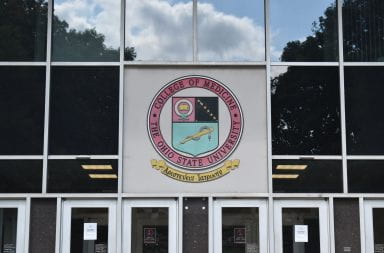
BuckeyeThon raised $98,096.20 less than this past year for pediatric cancer research in 2020. Credit: Courtesy of Buckeyethon
One thing agreed upon among Big Ten universities is that it’s for the kids.
Compared with other Big Ten universities, BuckeyeThon — Ohio State’s annual student fundraiser for pediatric cancer research — gets down on the dance floor earlier in the spring than other marathons, but with year-round fundraising efforts, it does not necessarily translate to the most money raised. BuckeyeThon raised $1.6 million — about $9 million less than Penn State raised in 2019 with its dance marathon and $98,096.20 under this past year’s total.
This year’s BuckeyeThon, which took place Friday and Saturday, raised $1,606,087.99 for Nationwide Children’s Hospital, according to previous Lantern reporting.
According to their respective websites, in 2019, BuckeyeThon raised $1,704,184.19 compared with Penn State University’s $10,621,683.70 — more than six times Ohio State’s figure — and Indiana University’s $4,257,143.23. University of Iowa raised $2,960,403.25 in 2019 and $2,879,755.26 this past weekend. Penn State’s THON is Feb. 21, and Indiana University Dance Marathon is Nov. 6.
“We applied the same strategy as we did last year,” Bill Tucker, media relations manager for BuckeyeThon and a fourth-year in human resources, said. “But for some reason, we had a lower number of participants. Every year, our event has a different group of students that come in, and we really don’t know what is going to work with them and what things are really going to hit home with people.”
Tucker said that every year, BuckeyeThon tries to match its effort with the atmosphere on campus, and despite it being a lower amount of engagement this year, any amount of money that goes toward Nationwide Children’s Hospital has an impact.
“I’m really proud of the students that fundraise an entire campus, that really got behind us to get to that $1.6 million,” he said.
BuckeyeThon is 24 hours, split into two shifts over the course of a weekend, according to its website. THON’s participants dance for 46 hours straight, Dan Mele, public relations director for THON, said in an email. IUDM’s 36-hour event can be split into 12-hour shifts, and Iowa keeps dancers on their feet for the 24 hours of its marathon, according to their websites.
BuckeyeThon raises money mainly through peer-to-peer fundraising, which involves students asking people in their networks to contribute to the cause, Tucker said.
“We really promote this through a consistent communication with family members, friends, posting on social media, communicating through email, text messages, even phone calls, really explaining what the cause is and why they’re passionate about it,” Tucker said.
He said other students come up with their own ways to raise money, including selling artwork or offering services, such as resume reviews, in exchange for donations. BuckeyeThon will also host events such as a barbecue, fashion show and Day of Miracles, a one-day fundraising push in October, which is considered the kickoff event for fundraising, Tucker said.
THON’s fundraising methods also include peer-to-peer fundraising, along with corporate and personal check solicitations, alternative fundraisers and THON Nation — the university’s nonstudent initiative that allows alumni and friends of THON to support Penn State’s mission, Mele said.
“One [method] that was new this year was the Dream Forward Campaign back in October,” he said. “This 16 day campaign had a goal of raising $500,000. We were fortunate to raise $701,331.64 within this timeframe.”
Dream Forward is a revamp of a previous THON campaign called One Day We Will Dance in Celebration, according to The Daily Collegian. With the same goal of fundraising, Dream Forward was extended from one week to 16 days, and its final day coincided with a THON 5k Oct. 29.
Indiana’s fundraising methods include online, cash and check donations, corporate sponsors, peer to peer and canning, which entails standing outside of public areas and asking passersby for donations, O’Connor said.
“That one’s always cool, even with the raise-awareness aspect because people will always be like, ‘Oh, what’s IUDM?’ or, ‘Where’s it going to?’ And then you can talk about it,” Chloe O’Connor, vice president of membership for IUDM, said.
Indiana also hosts two bigger fundraising events in a Top Golf outing and gala, O’Connor said.
Fundraising is a year-round effort for Big Ten universities, and BuckeyeThon encourages students to register as early as possible to allow plenty of time to reach the $250 minimum required to participate at the dance marathon, Tucker said.
Mele said THON’s fundraising is much more than just the weekend during which the dance marathon takes place.
Big Ten universities are competitive, and their dance marathons are no exception.
“There’s always motivation to raise more than we have in the past,” Tucker said. “That’s something that every program wants to do. In terms of other programs’ actual events, we do have one of the largest in terms of venue and participants. Even though our dance marathon doesn’t raise as much as other dance marathons, we consistently engage the most students on our campus relative to other programs.”
He added that BuckeyeThon — which was established in 2001 by a group of students passionate about philanthropy — prides itself on its engagement with students and spreading its messages across campus rather than to just a few hundred people.
Mele said THON also feels a sense of pride for what it has accomplished since its 1973 conception.
“We are continuously inspired by the work of other dance marathons and the impact they have on their respective beneficiaries,” he added.
IUDM, which was started in 1991 in honor of a Riley Hospital for Children patient, finds motivation in its rivalry and partnership with Purdue University, as both are housed in the same state and raise money for the same hospital, O’Connor said.
The patient, Ryan White, believed people should be accepted no matter what, no matter the illness, O’Connor said. IUDM’s mission is to honor White’s belief and save the lives of children like him.


